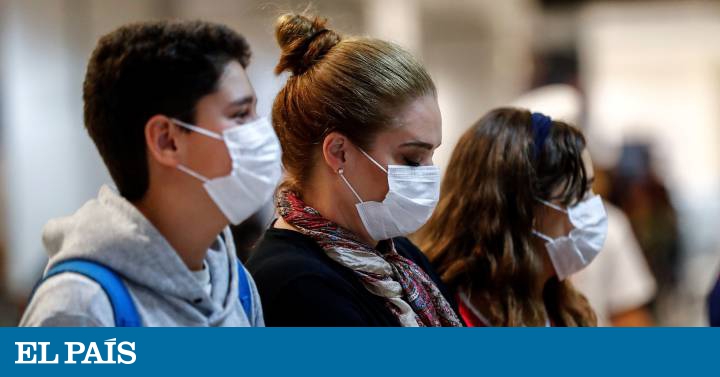Since the new coronavirus came into our lives (media and conversations for now: there are barely a handful of confirmed cases in the Spanish-speaking world) we have learned a lot about it. The range of uncertainty is still very high, but we already know it. With the available data, it seems likely that it is at least as contagious, lethal (mortality rate) and severe (rate of cases that would require hospitalization) such as influenza. It is very possible that it is worse. We cannot confirm it for sure because it is still early, and the numbers we have change a lot from country to country (for example: the estimated mortality of China and Italy is five or six times higher than that of South Korea, and in Iran it is a unknown because the number of real cases is too). In addition, although current figures point precisely in that direction, in the past we have found that the calculated severity of a new virus is readjusted over time, as we are able to better project the total number of cases as well as discriminate better between those who recover and those who do not.
But the important thing is not to try to guess the exact mortality rate, which will always depend on external factors. The key is that, even if we put ourselves in an optimistic scenario, adding a new virus with severity equivalent to the flu to the world catalog would be terrible news. Doing so in a short time, in addition, would test the pandemic response capacity of global systems. The Global Health Security Index precisely measures the protection power of such systems. The image for Latin America and the Caribbean is not very promising.
No country stands out for its preparation, and some are in a frankly weak situation: Guatemala, Haiti, Honduras, Guyana and, above all, Venezuela have a high vulnerability to new emergencies.
Thus, if the most pessimistic hypotheses are confirmed and it turns out that the virus that produces the COVID-19 disease is somewhat more contagious, or produces a greater proportion of serious cases, than the massive respiratory ailments that already coexist with humanity, then it would seriously put the health systems in Latin America (and around the world) are tested. Systems in which, as a rule, inequality in the degree of protection abounds. With an epidemic of considerable magnitude and severity, the differences would be felt with all intensity.
Something like this could already be intuited in China during the first weeks of infection: a recent study published in The Lancet shows that mortality was higher in those places with the highest incidence of cases. It is tragically logical: when the system feels saturated in a specific place, its ability to save lives by treating the most serious cases decreases.
An indicator that serves as the first approximation, included in the Global Index itself, is the number of hospital beds per inhabitant.
The variation is enormous: the countries at the top of the list quintuple the availability for hospital admissions of Bolivia or Nicaragua. Now, while a low value clearly indicates a problem, a high number does not mean salvation. If we remember the map, some of the countries with high apparent hospital capacity score low on the global index. If we put both dimensions in common the map is much tighter.
Here you can see how the countries that really have a degree of safety and equipment above average are few and concentrated in North America and the southern tip of the continent. There is more on the other end: with the guard down on both fronts, particularly in Central America. The small Caribbean islands have a kind of illusion of protection because of their high bed ratio favored by their small population, but their overall score is low. And with the large middle-high income countries (Colombia, Mexico), the opposite is true: they have better preparation than hospital access, despite the fact that despite probable improvements in recent decades, the equipment has not been able to maintain the demographic rhythm.
In fact, if we focus on one of these countries, Colombia, and observe what happens inside, we will realize that regional disparities go beyond country-to-country differences. Colombia is divided into departments that enjoy very different levels of income, wealth and, above all, state presence. As it could not be otherwise, the number of hospital layers per capita reflects territorial inequalities.
An inhabitant of the Caribbean coast or the coffee areas of Quindío or Antioquia (capital: Medellín) has more than twice as many effective places at their disposal compared to some areas of the South Pacific-Amazon (Cauca, Vichada, Vaupés). As can also be seen, the contribution of public infrastructure to the total is less than private. In Colombia, as in so many other places in Latin America and the Caribbean, there is no universal health system. The law creates a market for service providers to which workers must join. These, in turn, have access agreements with clinics and hospitals. There is a subsidized system of access to suppliers for those who are not willing to cover the cost, but at the top end there is also a private insurance market with access to the best facilities available only to those who can afford it. The resulting inequality in access to health services is mixed with territorial differences to create "blackheads." A local epidemic of a virus with high incidence, virulence and severity, precisely as a new aggressive-profile coronavirus, would put the system in check precisely at those points.
Hospital beds, of course, have to be operated by a specialized staff composed mostly of medical and nursing teams. It is expected that these three variables go hand in hand: when there is more than one of the components of the system, it would make sense to have more of the others. And so it is as a rule in the world.
However, Latin America has the peculiarity of being below the average relationship line. That is to say: in practically all countries of the region there are more doctors per capita than nurses or beds, underlining the comparative deficit of personnel and places.
As a result of all this, the region is not in the best possible way to face a potential pandemic. Even assuming a relatively low severity, if a new virus spreads sufficiently, areas with fewer resources and operating systems in place could saturate quickly (in some cases they are already up to date). If the new coronavirus has also arrived to stay, countries will have no choice but to improve and adapt their capabilities. Epidemiologists often joke that they spend each new viral emergency talking about "the next pandemic" and what should be done to prepare for their eventual arrival. Well: it's here. Others will follow in the future. The bottom line is that we don't forget where the holes are once the tide goes down.


/cloudfront-eu-central-1.images.arcpublishing.com/prisa/T33OEYIVAGSVWHAKW3OVHM6QO4.jpg)
/cloudfront-eu-central-1.images.arcpublishing.com/prisa/OMA4UFCHWBCAJBF6ZSPZWE4ARQ.jpg)
/cloudfront-eu-central-1.images.arcpublishing.com/prisa/EMYXC3EVHNEG3OJHGIQCB2IVYA.jpg)




/cloudfront-eu-central-1.images.arcpublishing.com/prisa/6GDDZWYNSVEJRDR6CKXCLQPGPQ.jpg)